|
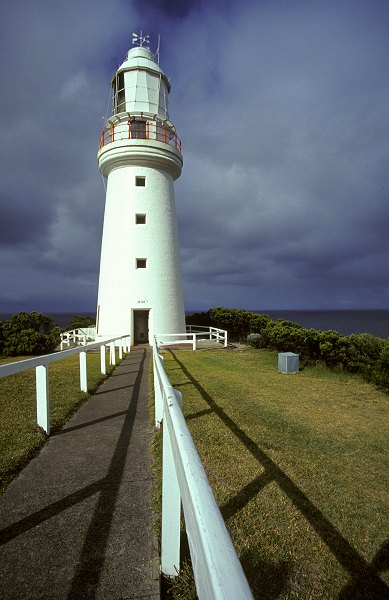 Cape Otway Lighthouse was the 8th lighthouse to be built in Australia. It is
the oldest existing lighthouse on the mainland.
Cape Otway Lighthouse was the 8th lighthouse to be built in Australia. It is
the oldest existing lighthouse on the mainland.
Vessels from England to Sydney first favoured the route via the South of
Tasmania before, but later adopted the shortened route through Bass Strait,
saving 1200 kilometres. The 90 kilometre wide passage between Cape Otway and
Cape Wickham on King Island, was referred to as "The Needles Eye".
After a long passage from the Cape of Good Hope, they then made their first
landfall in Australia in the vicinity of Cape Otway and the provision of a
lighthouse at this spot became of considerable importance.
In May 1835 the convict ship Neva was lost off the northern coast of King
Island. 135 female convicts, their 55 children, 30 male convicts, and all
the crew perished. Disaster struck again on King Island in 1843, when the
barque Rebecca was lost. In August 1845 the emigrant ship Cataraqui with 370
passengers and 38 crew, struck a reef off the southern coast of the island.
36 hours later just 9 survivors made it to shore. The Cataraqui is regarded
as Australia's worst maritime disaster.
The site for the lighthouse was selected in 1846 by Governor Latrobe on
his 3rd attempt to reach the Cape. A tender for construction of the tower
and keepers quaters, to plans prepared by Colonial Architect, Mortimer
Lewis, was accepted in October 1846. However, owing to very slow progress
being made the Government foreclosed on the contract and took over
construction work in October 1847.
During construction of the lighthouse access by sea was not always
practicable owing to difficulty of making a landing except in very
favourable weather. After many attempts and great hardship a track was
eventually cut through the dense forests of the Otway Ranges from the Colac
district some 40 mles to the northwest of the Cape.
The lantern and Catroptic light apparatus
were received from England in March 1848, and the light was finally
established in August 1848. Lieutenant Lawrence RN was the first
Superintendent of the lighthouse.
The principal access to the station for stores continued to be by
sea from Melbourne until the railway was constructed over the Otway
Ranges to Lavers Hill, 17 miles northwest of the lighthouse. Bullock
wagon and horses were used from there.
About 1937 the road from Apollo Bay to Cape Otway was made
passable for motor traffic and this is now the means of access.
In June 1938, a marine radio beacon was put into operation at the
lighthouse to provide an additional aid of those in the area. The
radio beacon transmits a characteristic signal of 2 minutes duration
at intervals of 6 minutes in fog and thick weather and 30 minutes in
clear weather. By means of direction finding equipment,
vessels can obtain a bearing of Cape Otway radio beacon at distances
of up to 100 miles in any weather.
In fog, explosive fog rockets are fired every 10 minutes. These
have a variable range, depending upon atmospheric conditions, but
can normally be heard for about 5 miles, and are used to warn
vessels of their near approach to the Cape. Fogs are experienced at
all times of the year principally between the months of November and
March.
The light was converted to electricity on 25 October 1939. In
1994 with the introduction of satellite navigation systems, the 'Old
Light' was turned off and replaced with a small solar powered
signal. In January 1997 the lightstation was leased by Parks
Victoria to a small local family owned company.
Tours
The tower is open to
visitors and tours are conducted daily from 9.30am
Accommodation
Comfortable accommodation is available in the sandstone four-bedroom
Head Keeper's residence, or in the two 2 bedroom Assistant Keeper's
quarters. Tariff as at June 1998 - start from $445 for 4 and $245
for couples. Minimum stay is 2 days
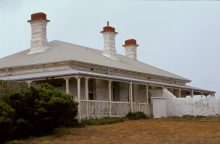 The original Catroptic light apparatus was replaced with a Chance Bros 1st Order,in 1891.
The original Catroptic light apparatus was replaced with a Chance Bros 1st Order,in 1891.
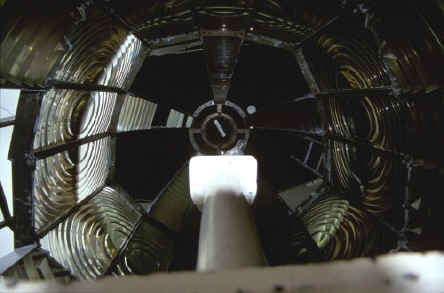 In 1994 with the introduction of satellite navigation systems, the 'Old
Light' was turned off and replaced with a small solar powered signal.
In 1994 with the introduction of satellite navigation systems, the 'Old
Light' was turned off and replaced with a small solar powered signal. 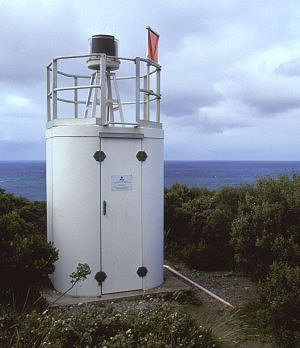
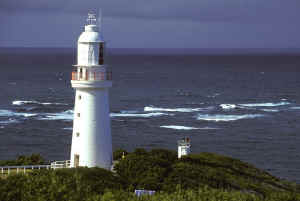
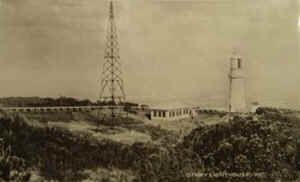
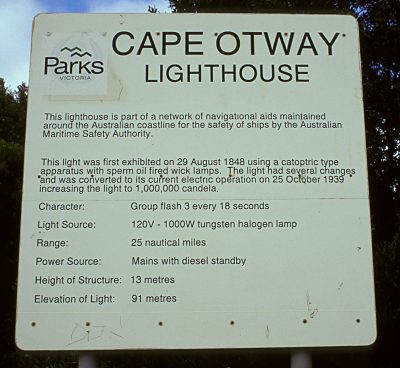


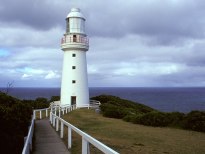

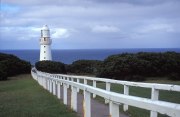
|
 Cape Otway Lighthouse was the 8th lighthouse to be built in Australia. It is
the oldest existing lighthouse on the mainland.
Cape Otway Lighthouse was the 8th lighthouse to be built in Australia. It is
the oldest existing lighthouse on the mainland.
 The original Catroptic light apparatus was replaced with a Chance Bros 1st Order,in 1891.
The original Catroptic light apparatus was replaced with a Chance Bros 1st Order,in 1891. In 1994 with the introduction of satellite navigation systems, the 'Old
Light' was turned off and replaced with a small solar powered signal.
In 1994 with the introduction of satellite navigation systems, the 'Old
Light' was turned off and replaced with a small solar powered signal. 







